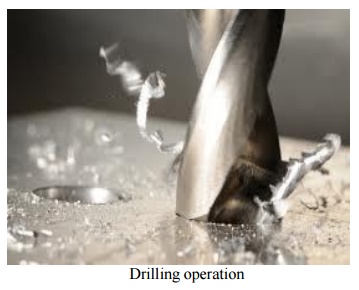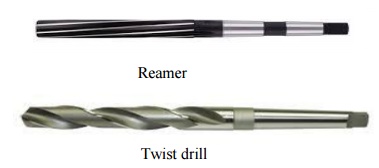Chapter: Mechanical : Manufacturing Technology : Shaper, Milling and Gear Cutting Machines
Drilling and Reaming
Drilling and Reaming
Drilling
and reaming operations

Drilling
operation
Drilling
is used to drill a round blind or through hole in a solid material. If the hole
is larger than ~30 mm, its a good idea to drill a smaller pilot hole before
core drilling the final one. For holes larger than ~50 mm, three-step drilling
is recommended; v Core drilling is used to increase the diameter of an existing
hole; v Step drilling is used to drill a stepped (multi-diameter) hole in a solid
material;
Counterboring provides a stepped
hole again but with flat and perpendicular relative to hole axis face. The hole
is used to seat internal hexagonal bolt heads;
Countersinking is similar to
counterboring, except that the step is conical for flat head screws:
Reaming provides a better
tolerance and surface finish to an initially drilled hole. Reaming slightly
increases the hole diameter. The tool is called reamer;
Center drilling is used to drill
a starting hole to precisely define the location for subsequent drilling. The
tool is called center drill. A center drill has a thick shaft and very short
flutes. It is therefore very stiff and will not walk as the hole is getting
started;
Gun drilling is a specific
operation to drill holes with very large length-to-diameter ratio up to L/D
~300. There are several modifications of this operation but in all cases
cutting fluid is delivered directly to the cutting zone internally through the
drill to cool and lubricate the cutting edges, and to remove the chips (see
Section 5.6 Cutting Fluids);
Drills
and Reamers
Reamer

Twist
drill
The twist drill does most of the
cutting with the tip of the bit. It has two flutes to carry the chips up from
the cutting edges to the top of the hole where they are cast off. The standard
drill geometry
The typical helix angle of a
general purpose twist drill is 18~30 degree, while the point angle (which
equals two times the major cutting edge angle, see page 101) for the same drill
is 118deg.
Some
standard drill types are,
straight shank: this type has a cylindrical shank and is held
in a chuck;
taper shank: his type is held directly in the drilling machine
spindle.
Reamers
The reamer has similar geometry.
The difference in geometry between a reamer and a twist drill are:
The reamer contains four to eight straight or helical flutes,
respectively cutting edges.
The tip is very short and does not contain any cutting edges.
Related Topics